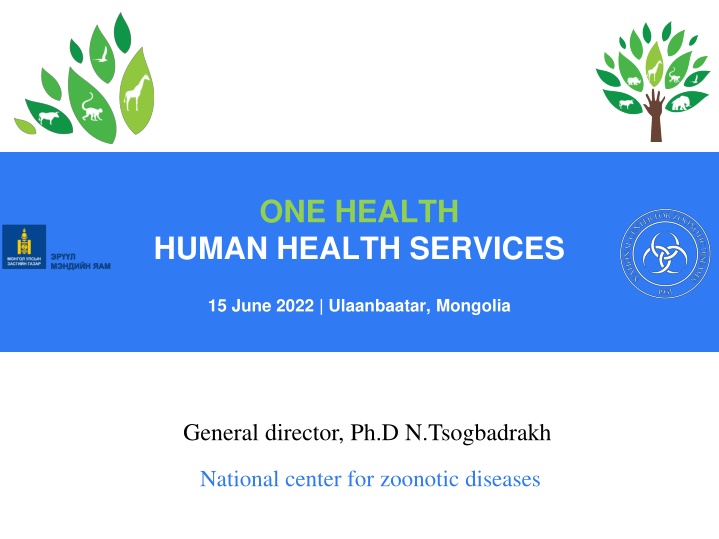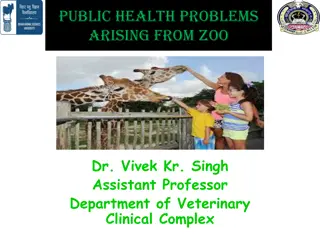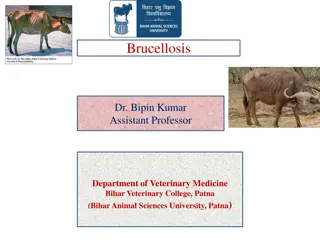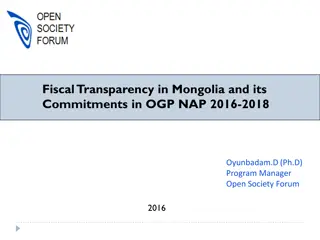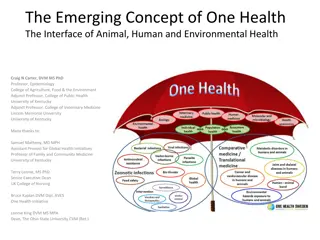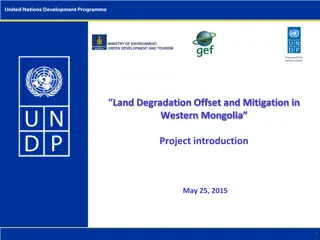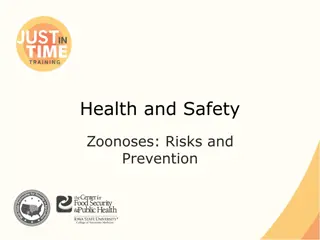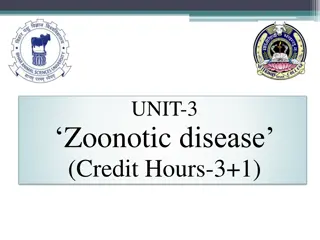Zoonotic Diseases in Mongolia: A One Health Perspective
High risk of zoonosis in Mongolia is evident due to various factors such as livestock practices, wildlife diseases, and environmental changes. The National Center for Zoonotic Diseases in Mongolia plays a crucial role in studying, preventing, and raising awareness about over 160 zoonotic infectious diseases that can be transmitted from animals to humans. The center focuses on human zoonotic diseases, natural foci in zoonotic diseases, and the need to prioritize the study of endemic diseases. The data presented highlights the significant testing and positive cases of zoonotic diseases in Mongolia over the years, emphasizing the importance of a holistic approach towards health services.
Download Presentation

Please find below an Image/Link to download the presentation.
The content on the website is provided AS IS for your information and personal use only. It may not be sold, licensed, or shared on other websites without obtaining consent from the author.If you encounter any issues during the download, it is possible that the publisher has removed the file from their server.
You are allowed to download the files provided on this website for personal or commercial use, subject to the condition that they are used lawfully. All files are the property of their respective owners.
The content on the website is provided AS IS for your information and personal use only. It may not be sold, licensed, or shared on other websites without obtaining consent from the author.
E N D
Presentation Transcript
ONE HEALTH HUMAN HEALTH SERVICES 15 June 2022 | Ulaanbaatar, Mongolia General director, Ph.D N.Tsogbadrakh National center for zoonotic diseases
One health National center for zoonotis diseases in Mongolia
High risk of zoonosis in Mongolia . - - 67M postural livestock Intensified livestock breeding Dependence on food consumption Wildlife Diseases, Uncontrolled. - More than 140 species of mammals, 22 species of mosquitoes, 158 species of flea parasites 43 species of Ticks - - - - - Climate change, Urbanization, Population density, Tourism, Geographical location - - - - - Risk factors of zoonosis in Mongolia Risk factors of zoonosis in Mongolia Risk factors of zoonosis in Mongolia Neglected Need to study 26 Endemic- 7 . 0 4 0 3 0 2 0 1 Transferring report 12 PRIORITY OF HUMAN ZOONOTIC DISEASES National center for zoonotis diseases in Mongolia
High risk of zoonosis in Mongolia Human zoonotic diseases Natural foci in Zoonotic diseases in Mongolia Confirmed Suspected 2100 2000 1900 1800 1700 1600 1500 1400 1300 1476 1200 1100 1000 900 1228 1175 800 876 700 1022 600 613 500 592 400 300 307 486 332 200 332 238 291 282 222 100 206 183 92 66 43 0 2012 2013 2014 2015 2016 2017 2018 2019 2020 2021 Human zoonotic diseases in Mongolia Number of samples tested at risk 400,000 374,508 Suspected samples 350,000 positive samples 300,000 250,000 200,000 150,000 110,000 100,000 56,000 40,415 50,000 13,060 14,067 16,537 2307 13227 5,428 5,105 7621 7489 5105 1,412 3366 1068 661 522 240 0 2012 2013 2014 2015 2016 2017 2018 2019 2020 2021 National center for zoonotis diseases in Mongolia
Zoonotic diseases in Mongolia Bacterial Protozoa Tick borne Helminthes Virus Echinococcosis Rabies Plague Malaria TB Encephalitis Belt worms SARS Anthrax Toxoplasmosis Lyme disease Teniasis MERS Cholera Babesiosis TB rickettsioses Cysticercosis HPAI Kriptosporidiosis Brucellosis Japan encephalitis Round worms EBOLA Anaplasmosis Nematoides Lassa fever Ehrlichiosis Flatworms FMD Tetanus Beef liver parasites, etc. We need to prevent, warn, and study about 160 zoonotic infectious diseases that can be transmitted from animals to humans. National center for zoonotis diseases in Mongolia
LEGISLATION National level International Law on Disaster Protection Law on Animal Health /DPM 2017/ Order of Public health emergency, inter-sectoral information exchange, quickly response, and joint risk assessment Joint order MoFALI MoH Update to approve rules of operation of the joint working group to protect public health from zoonotic diseases. - - APSED III International health regulation (IHR) HEALT approach - - - - LEGAL - 'One Health' is an approach to designing and implementing programmes, policies, legislation and research in which multiple sectors communicate and work together to achieve better public health outcomes (WHO, 2017) National center for zoonotis diseases in Mongolia
Structure of veterinary medical coordination mechanism PRIORITIES ZOONOTIC DISEASES OF SURVEILLANCE, 2012 UPDATED 2019 Chair, Vice minister of MOFALI Ministry of health Under joint investigate Priorities zoonotic diseases of surveillance 9. Malaria 10. Dengue fever 11. Yersinosis 12. Toxoplasmosis 13. West Nile Fever 14. Japan encephalitis 15. Hanta virus 16. Criptospirosis 17. Erizopeliod 18. Pasteriolosis Vice chair, Director of public health department MoH Vice chair, Director of General authority for veterinary services 1. Plague 2. Avian influenza 3. Anthrax 4. Rabies 5. TBE 6. Brucellosis 7. Ehinococcus 8. Tularemia Secretary, Specialist of General authority for veterinary services Secretary, General director NCZD Technical Working Group Operating procedure Members National center for zoonotis diseases in Mongolia
Implementing One health NATIONAL LEVEL Ministry of health Ministry of food and agriculture light industry General authority for veterinary services government implementing agency National emergency management academy General agency for specialized inspection National center for zoonotic diseases National center for communicable diseases 8 AGENCY & CENTERS LOCAL LEVEL 21 Health department Veterinary department Center for zoonotic diseases PROVINCE National center for zoonotis diseases in Mongolia
Results of joint surveillance zoonotic disease in 2008-2014 WITH State Central Veterinary Laboratory GOOD EXPERIENCE N= 111 soum of 21 province National center for zoonotis diseases in Mongolia
Activities zoonosis & One health - Joint surveillance - Joint response - Simulation - Evaluation - Develop the document - Joint project for research (Externally funded) - Joint conference and workshop - Joint develop strategy - Joint scientific work National center for zoonotis diseases in Mongolia
Evaluation of zoonotic mechanism in Mongolia Evaluation criteria Level 1.Response measure of surveillance and risk assessment Early warning surveillance system Developed capacity Capacity of risk assessment Developed capacity Capacity of quick response measures Developed capacity 2. Laboratory diagnostic capacity Laboratory diagnostic capacity Limited capacity Surveillance response system and role of laboratory Sustained Capacity Laboratory network and connection Limited capacity Laboratory biosafety Sustained Capacity 3. Zoonosis mechanism Surveillance information sharing Limited capacity General control mechanism of joint response measure Sustained Capacity Joint response measures of risk reduction Sustained Capacity Joint scientific study Sustained Capacity National center for zoonotis diseases in Mongolia
Further Increase zoonosis coordination mechanism Create online database information management (Vaccination, bio product, laboratory result, bio sample and natural focal information etc.) Strengthen inter sectoral coordination mechanism (joint survey, training, information sharing and research) Increases laboratory diagnostic capacity Diagnosis of NTD, vector borne diseases, emergency and vector borne disease Create laboratory network and connection Accreditation license Increase sample transportation management Field laboratory training program Cell culture Surveillance system Sero survey in pop Expand to vector in foci (Tick, mosquito and some inspect) Create vaccine monitoring Strengthen EOP action Practice training: During case and event action between local organization Training: Increase knowledge of local and national specialist National center for zoonotis diseases in Mongolia
One Health is everyones job Thank you National center for zoonotis diseases in Mongolia
